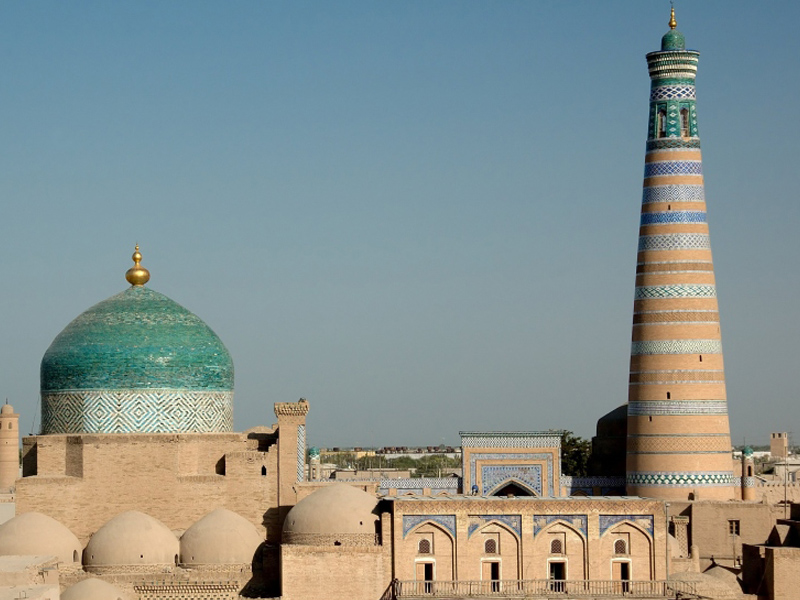



Attraction

Recreation

Vigorous growth took place in Khiva in the nineteenth century, as it developed along with the rest of the khanate. There was intensive construction activity in Ichan-kala and Dishan-kala.
Work was done on the royal buildings of the Ichan-kala. In this city limited by fortress walls, where every new building impinged on already existing structures, such intensive construction was in fact multi-stage reconstruction. In order to give a completed form to the architectural complexes of different periods architects had to display great professional tact and skill, as they turned the city into a huge distinctive architectural ensemble.
The full variety of Khiva's buildings was organically combined. It is worth noting that the high terraces (aivans) were separated. They were opened to the north, where prevailing cool winds blow. From the Khazarasp gates, chains of minarets stood like exclamation marks, punctuating the main compositional hub of the city. The minarets of Palvan-kari Said Shelikerbai, Juma, Kalta minar and Sheikh Ka-landar-bobo, which have different forms and size, impart uniqueness to Khiva.
Usually minarets fulfilled three functions: they served for calling the believers to prayer, as observation posts in the period of feudal internecine warfare, and, lastly, as points of orientation in the city. It is difficult to be lost in Khiva when the well-proportioned minaret of Islam Khodja is seen from everywhere. The Khiva minarets are one of the considerable achievements of the medieval architecture and have their own place in the panorama of the city.
Between the main roads of the city, which cross Ichan-kala and run radially through Dishan-kala, are squeezed the densely populated quarters. They are joined by narrow streets, passages and blind alleys. The blocks of Khiva, as in the other historically formed cities of Uzbekistan, were settled by craftsmen of the same specialty who formed their community. The core of the quarter is a garden of trees, a mosque, a low minaret or a picturesque reservoir. Tea-rooms (chaikhanas) and household buildings are here as well. The living quarters form the substance of the city; the monumental public structures: madrasas, mosques and minarets stand out from within them.
The main waterways of the city are canaling Zakash, Palvan-yab and arik Sirchali. They irrigate Dishan-kala, where you can see gardens and parks that are almost invisible in Ichan-kala. The monumental walls of the city represent a vivid pattern of the Khorezm fortification constructions. Their height are about ten metres, the foundation is five — six metres thick. They are steep from inside and have a more sloping surface from outside. You can see massive semicircular turrets about every thirty metres. The cogged parapet tops the walls. The narrow loopholes have probably served the inhabitants of Khiva in defending the city several times. Moats were dug out at the foot of the walls. The old construction of Khiva was made of large raw bricks and clay. This way of building is characteristic of the early medieval periods.
In the southeastern corner of Ichan-kala you can see the remains of the rectangular tower, which is the evidence of the earliest traditions of a fortress construction of Khorezm. There were preserved hundreds of brick epitaphs at the foot of the city walls. This ancient tradition probably appeared because the population had to bury on the heights around the city.
There are four arched gates flanked with circular towers: Baghcha-darvoza is in the north, Palvan-darvaza is in the east Tash-darvaza is in the south and Ata-darvaza is in the west. The gates were erected around Dishan-kala in the nineteenth century. The most significant preserved structure from the architectural cluster is Kosh-darvaza (double gate). There are two arched passages between the three cylindrical towers. Over it there is a traditional gallery crowned with cogged parapet. The decorative belts of colored ceramic slabs add splendor.
The bazaars, caravanserais, and bathhouses were at the city gates. Brisk trade is in full swing at the Khiva gates to this day. Usually in populous places near the bazaars the cult complexes were built. These places include the mosques, madrasas, and memorial monuments. The unique ensembles of Khiva have magnetic power.
From the preserved monuments of the city, which belong to the earliest period, is the mausoleum of Said Alia ad-Din in the center of Ichan-kala. This is a two-chamber tomb with an asymmetrical composition: a praying mosque (ziaratkhana) attached to a square mausoleum (gurkhana) from the western side. A simple wood fence, which is adjacent to the wall, separates the ziaratkhana from the gurkhana. The praying mosque is almost twice the size of the tomb. The two chambers are covered with cupolas: an octagonal form on the gurkhana and rounded form on the ziaratkhona.
A splendid tomb of prismatic form, 2x1.2 m. in size, 1.25 m. high, stands out in the modestly decorated interior of the gurkhana. The tomb lies on a stepped low podium. Its facing is a classical specimen of the Khorezm artistic school of the nineteenth century. The edges of the majolica tomb are divided into right-angled panels; the borders are covered with small plant patterns, white against the dark-blue background. The stylized stalks, leaves and flowers are painted freely. There are Arabic inscriptions and the date of Sheikh Alia ad-Din's death (702 H, 1302) on the wooden slab. According to the writing on the frieze, the mausoleum was built by the disciple and successor of the Sheikh, amir Kulyal (died in 1370).
The majolica tomb of this mausoleum is a genuine masterpiece of decorative art. It can be compared with the tomb of Kucam Abbas in Samarkand and Kubra in Kunyu-Urgench, which are close in the time of their construction. Undoubtedly, the monument was created in the Golden Horde period the architectural and decorative art.
Another memorial ensemble, devoted to Pakhlavan Makhmud, is situated to the south of Said Alia ad-Din's tomb. It had been developing for the six centuries and contains tombs, madrasas, qorikhana (house or room for reading Quran), a summer mosque, a yard with a shady tree and a well.
In the eighteenth century Shakh Niyaz-khan built a darvazkhana. In the nineteenth century the ensemble was radically reconstructed. The darvazkhana, yard and portal-cupola hall opened in three directions, are located here on the longitudinal axis. The burial vault of Mukhammad Rahim-khan is on the pentahedral niche of the hall on the symmetrical axis. In the northwestern corner of this wall the tombs of Abdulghazi-khan and Anush-khan were placed. Three small chambers adjoin the large hall from the western side. The middle one, a ziaratkhana, is connected by a passage to the hall and the tomb of Pakhlavan Makhmud. The third house is connected with a yard. The constructions of the eastern side are asymmetrical. Here a corridor is erected, leading to the rectangular room, covered with two cupolas. There is an exit to the cemetery from here. The two-cupola house there is a deep niche with Alla-kuli-Khan's burial vault. So, by being buried near to Pakhlavan Makhmud, the Khiva khans of the Kungrad House obtained eternal peace.
The fagade of the big hall, facing the yard, was designed and decorated in a style peculiar to the Khiva School of art. Its colors are blue, sky blue and white. One can see the bright turquoise finish of this largest cupola in the city with a golden cap from anywhere. The fantasy of the Khiva masters who decorated the ensemble from the floor up to the zenith of the cupolas, displayed an inexhaustible fund of inventiveness. The wonderful curved doors with encrustation and inlay details of ivory and copper deserve special attention. The date of the ensemble, 1353, is painted here. The name of the Khorezm engraver nadir Muhammad was preserved on the door of the burial vault. The names of the masters who created the paneling: Mulla Mukhammad, Sufi Mukhammad, Abdulla, and others are known from the inscription.
The ensemble of Pakhlavan Makhmud is one of the best creations of the Khorezm architects. The travelers of the mid-nineteenth century who visited Khiva noted that there were twenty-two madrasas here. It was the evidence of the educational level of the Khorezm inhabitants. The rulers of the Khanate paid great attention to the education of young people, in reality madrasas were Muslim universities, where along with theology they studied history, geography, astronomy and other subjects.
In 1616 Arab Mukhammad-khan ordered a mosque built to celebrate the transfer of the capital of Khorezm from Kunya-Urgench to Khiva. At first, it was a one-story framed building. Its carved wooden columns with an open aivan (veranda) and composition ceilings, which are put in the yard Tash-hauli. 300 hundred years later under Alla-Kuli-Khan the building was reconstructed. At present it is a building with a one-yard, two-story symmetric composition. The cylindrical towers are erected in the corner. On the longitudinal axis is a summer mosque, opened to the yard. The main fagade is modest, without colored decoration and the rest facades are also blank walls. The madrasa attracts attention with its compactness, proportion, and size.
By the mid of the seventeenth century a neighborhood Ak-machet was built in the eastern part of Ichan-kala. The asymmetric building with a three-sided aivan was erected on the high platform. Archaeological study discovered that its foundation was laid about four meters deep, which gives the building stability and safety under its seismic load. The cubic hall features a conic cupola. There is a mirkhab (niche), orienting the praying people to the Muslim sacred city, Mecca, in the southern wall of the mosque. The flat aivan supports a number of wooden constructions. The wide underlines the public purpose of the building. Four windows light the hall. Plaster pand-jara are set in them. The facades and interior of the mosque are plastered. On the carved ornament of the door are names of two masters — Mur Muhammad, Kalandar — and two dates — 1832, 1842 — probably, the years of repair or installation of the door. Ak-mechet (white mosque) is memorable for its vividness of the composition, clean form, and expressive silhouette.